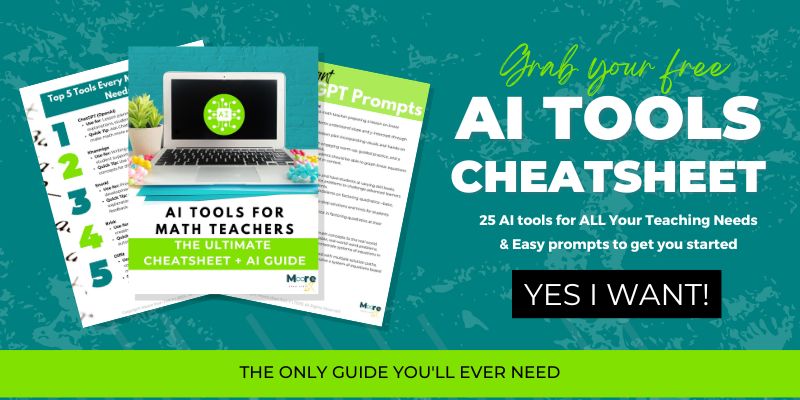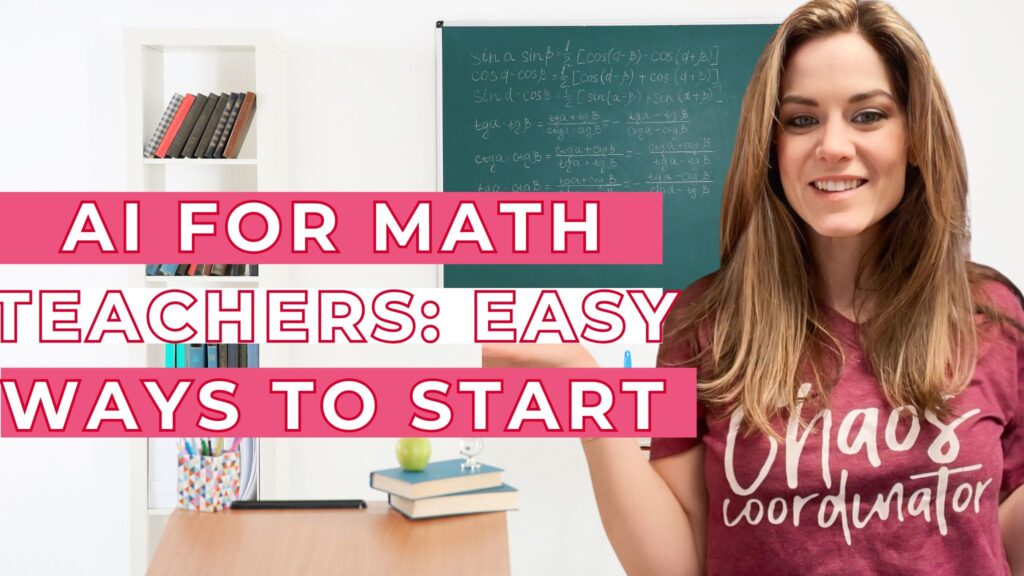What if AI could save you hours of planning each week, give your students more support, and make your job just a little easier?
AI might sound overwhelming, but it doesn’t have to be. In this episode of The Modern Math Teacher Podcast, we’re exploring three easy, practical ways to start using AI tools in your math classroom—without needing a tech degree or sacrificing your weekend.
Whether you’re curious about AI math tools, looking for ideas to make math more engaging, or just want help simplifying your workflow, I’ve got you covered.
If you’re ready to make AI work for you (not against you), keep reading—or tune in to the full episode for a deeper dive into my favorite tools, tips, and strategies.
🎧 Listen to the Episode Here
📺 Watch on YouTube Here
Why AI Is a Game-Changer for Math Teachers
Let’s face it: we wear a lot of hats. Between lesson planning, differentiation, grading, and engagement, it’s easy to burn out. But with the right AI math tools, we can automate the boring stuff and focus on what matters most—teaching and connecting with students.
Here’s how AI is transforming math classrooms:
✅ Lesson Planning: AI can generate scaffolded questions, warm-ups, and full lesson plans. I love using the CRAFT framework with AI to make lessons more purposeful and student-centered.
✅ Differentiation & Feedback: AI math generators like Snorkl or ChatGPT can personalize problems, provide instant feedback, or adjust rigor on the fly.
✅ Real-World Math Questions: Want more relevant warm-ups or project ideas? Use AI to create custom word problems based on your students’ interests (and even their names!). It’s a total game-changer for engagement.
Three Simple Ways to Use AI in Math Right Now
If you’re just getting started, here are three high-impact ways to dip your toes into the world of AI in education—no tech overwhelm required.
1️⃣ Lesson Planning with AI
Drop in your topic and ask your favorite AI tool (like ChatGPT) to create a warm-up, scaffolded questions, and a summary task. You can even ask it to differentiate based on student needs. It’s like having a co-teacher at your fingertips.
🔧 Pro Tip: Use the CRAFT framework to structure your prompts and get more targeted results.
2️⃣ Student Support with AI Chat Tools
Let’s talk about Mathway for a second. I know—it’s gotten a bad rap. But what if we flipped the script and taught students to use it for error analysis? Combine it with self-checking assignments or posted answer keys, and let students reflect on their mistakes using AI-generated explanations.
This isn’t cheating. It’s metacognition, baby. 🧠
3️⃣ Boosting Engagement with AI-Powered Scenarios
Use tools like KhanMigo or ChatGPT to create real-world math problems based on your students’ hobbies, sports teams, or future careers. Your students will be blown away when they see their own names in the problem.
Try This AI Math Activity This Week
Looking for an easy way to test it out?
💡 Try this: Have students explore a real-world dataset, ask AI for help analyzing it, and use the results to make predictions.
Low-prep. High engagement. Real-world relevance.
This could be a great way to intro statistics, exponential functions, or modeling—depending on the dataset you use!
Read more about AI For Math Teachers here.
Download the Free AI in Math Cheat Sheet
Ready to start experimenting with AI? I’ve created a FREE cheat sheet just for math teachers with:
- ✔️ 25 of my favorite AI math tools
- ✔️ Quick-start prompts for lesson planning, engagement, and differentiation
- ✔️ My personal top 5 go-to tools and how I use them every week
👉 Download the AI in Math Cheat Sheet Here

Tools + Resources from This Episode
🧠 Snorkl – Instant feedback & student thinking analysis
📘 Math Teachers Guide to AI
📄 CRAFT Framework Overview
📥 AI in Math Cheat Sheet – Free Download
AI is here to stay—and if we learn how to use it with purpose, it can be one of the most powerful tools in our teaching toolbox.
Whether you’re automating lesson planning, personalizing student support, or creating real-world math questions that actually make sense, I hope this episode gives you the inspiration (and permission!) to try something new.
Until next time,
Keep experimenting with AI for you and your students—and as always, keep it real.









